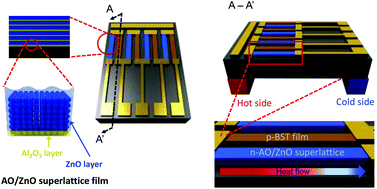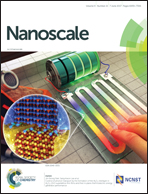Control of phonon transport by the formation of the Al2O3 interlayer in Al2O3–ZnO superlattice thin films and their in-plane thermoelectric energy generator performance†
Abstract
Recently, significant progress has been made in increasing the figure-of-merit (ZT) of various nanostructured materials, including thin-film and quantum dot superlattice structures. Studies have focused on the size reduction and control of the surface or interface of nanostructured materials since these approaches enhance the thermopower and phonon scattering in quantum and superlattice structures. Currently, bismuth–tellurium-based semiconductor materials are widely employed for thermoelectric (TE) devices such as TE energy generators and coolers, in addition to other sensors, for use at temperatures under 400 K. However, new and promising TE materials with enhanced TE performance, including doped zinc oxide (ZnO) multilayer or superlattice thin films, are also required for designing solid-state TE power generating devices with the maximum output power density and for investigating the physics of in-plane TE generators. Herein, we report the growth of Al2O3/ZnO (AO/ZnO) superlattice thin films, which were prepared by atomic layer deposition (ALD), and the evaluation of their electrical and TE properties. All the in-plane TE properties, including the Seebeck coefficient (S), electrical conductivity (σ), and thermal conductivity (κ), of the AO/ZnO superlattice (with a 0.82 nm-thick AO layer) and AO/ZnO films (with a 0.13 nm-thick AO layer) were evaluated in the temperature range 40–300 K, and the measured S, σ, and κ were −62.4 and −17.5 μV K−1, 113 and 847 (Ω cm)−1, and 0.96 and 1.04 W m−1 K−1, respectively, at 300 K. Consequently, the in-plane TE ZT factor of AO/ZnO superlattice films was found to be ∼0.014, which is approximately two times more than that of AO/ZnO films (ZT of ∼0.007) at 300 K. Furthermore, the electrical power generation efficiency of the TE energy generator consisting of four couples of n-AO/ZnO superlattice films and p-Bi0.5Sb1.5Te3 (p-BST) thin-film legs on the substrate was demonstrated. Surprisingly, the output power of the 100 nm-thick n-AO/ZnO superlattice film/p-BST TE energy generator was determined to be ∼1.0 nW at a temperature difference of 80 K, corresponding to a significant improvement of ∼130% and ∼220% compared to the 100 nm-thick AO/ZnO film/p-BST and n-BT/p-BST film generators, respectively, owing to the enhancement of the TE properties, including the power factor of the superlattice film.



 Please wait while we load your content...
Please wait while we load your content...